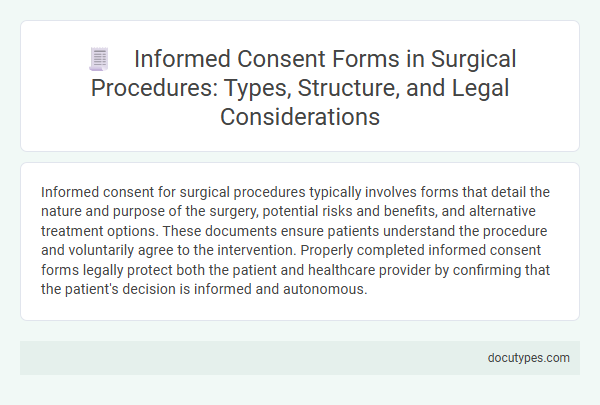Informed consent for surgical procedures typically involves forms that detail the nature and purpose of the surgery, potential risks and benefits, and alternative treatment options. These documents ensure patients understand the procedure and voluntarily agree to the intervention. Properly completed informed consent forms legally protect both the patient and healthcare provider by confirming that the patient's decision is informed and autonomous.
Introduction to Informed Consent in Surgical Procedures
| Introduction to Informed Consent in Surgical Procedures |
|---|
| Informed consent is a critical legal and ethical requirement before any surgical procedure. It ensures that patients understand the nature, benefits, risks, and alternatives of the surgery. This process empowers patients to make voluntary and informed decisions about their healthcare. The forms used for informed consent vary by institution but generally include detailed explanations tailored to specific surgeries. These documents help confirm that the patient has received adequate information, had the opportunity to ask questions, and voluntarily agrees to proceed with the surgery. |
Importance of Informed Consent for Patient Safety
Informed consent forms in surgical procedures typically include general consent, procedure-specific consent, and anesthesia consent. These documents ensure patients understand the risks, benefits, and alternatives before proceeding with surgery.
The importance of informed consent lies in promoting patient safety by fostering transparent communication between healthcare providers and patients. Properly obtained consent helps prevent medical errors, legal disputes, and supports ethical medical practice.
Types of Informed Consent Forms in Surgery
Informed consent in surgical procedures is documented through specific forms that ensure patient understanding and agreement. These forms vary based on the complexity and type of surgery performed.
- General Consent Form - This form covers routine surgical procedures and grants permission for standard treatment and care.
- Procedure-Specific Consent Form - Detailed information is provided about the particular surgery, associated risks, benefits, and alternatives.
- Emergency Consent Form - Used when immediate surgery is required, often with limited patient communication due to urgent conditions.
Accurate use of these informed consent forms is critical for legal compliance and patient safety in surgical care.
Essential Components of Surgical Consent Forms
Surgical consent forms are legal documents designed to ensure that patients understand the risks, benefits, and alternatives to a procedure before agreeing to surgery. These forms are essential for protecting patient rights and facilitating clear communication between healthcare providers and patients.
- Patient Identification - Confirms the identity of the patient to avoid any errors or mix-ups in the surgical process.
- Procedure Description - Provides a detailed explanation of the surgical procedure, including its purpose and the steps involved.
- Risks and Benefits Disclosure - Outlines potential risks, complications, and benefits to inform the patient's decision-making.
- Alternatives to Surgery - Lists non-surgical options and their potential outcomes to offer a comprehensive overview of choices.
- Patient Questions and Consent - Documents the patient's questions and their voluntary agreement to undergo the procedure.
Structuring an Effective Informed Consent Document
Informed consent forms for surgical procedures typically include detailed descriptions of the surgery, potential risks, benefits, and alternative treatments. Structuring an effective informed consent document involves clear, concise language tailored to the patient's comprehension level to ensure full understanding. Essential elements include patient identification, procedure specifics, risk acknowledgment, and patient or guardian signatures to validate consent legally.
Legal and Ethical Foundations of Informed Consent
Informed consent in surgical procedures is a critical legal and ethical requirement that ensures patient autonomy and safety. Various forms are utilized to document the patient's agreement after understanding the risks, benefits, and alternatives of the surgery.
- General Consent Form - This form confirms the patient's overall agreement to receive medical care, including surgery, and is signed upon hospital admission.
- Procedure-Specific Consent Form - Detailed documentation that explicates the specific surgical intervention, outlining risks, benefits, and alternatives tailored to the procedure.
- Capacity and Voluntariness Assessment - Forms or documentation verifying the patient's competence to consent and ensuring the decision is made voluntarily without coercion.
Common Challenges in Obtaining Surgical Consent
Informed consent forms for surgical procedures typically include detailed explanations of the surgery, potential risks, benefits, and alternatives. These documents aim to ensure patients understand and voluntarily agree to the treatment.
Common challenges in obtaining surgical consent involve patient comprehension, language barriers, and time constraints during preoperative consultations. Medical staff must address varying levels of health literacy and provide clear, accessible information. Failure to do so can lead to legal complications and compromised patient safety.
Documentation Standards and Best Practices
In surgical procedures, informed consent forms are essential documents that outline the procedure, associated risks, benefits, and alternatives. These forms must comply with legal and institutional standards to ensure patient understanding and voluntary agreement.
Documentation standards require that informed consent forms include clear language, patient identifiers, and signatures from both the patient and the healthcare provider. Your surgical team should also provide a copy of the signed consent form for your records, ensuring transparency and accountability throughout the process.
Special Considerations: Pediatric and High-Risk Cases
Which forms are used for informed consent in pediatric and high-risk surgical cases? Specialized consent forms address unique risks and parental or guardian authorization. These forms ensure comprehension of potential complications and necessary precautions for vulnerable patients.
Which Forms Are Used for Informed Consent in Surgical Procedures? Infographic

